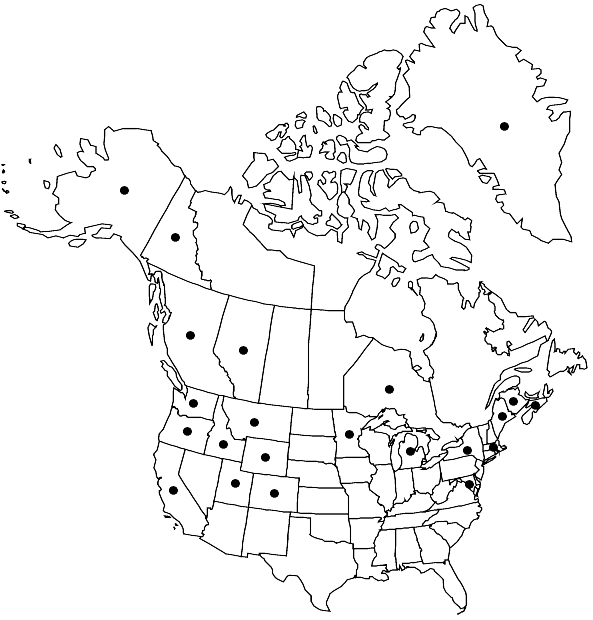Schistidium agassizii
Musc. Hepat. U.S., 104. 1856,.
Plants in open, rarely compact tufts or mats, dark olivaceous, sometimes brownish or black. Stems (0.9–)1.3–2.5(–5) cm, central strand absent or indistinct. Leaves erect or curved, often toward stem, sometimes contorted when dry, linear-lanceolate to ligulate, sometimes oblong-lanceolate, weakly keeled or concave proximally, usually nearly flat distally, sometimes concave or rarely weakly keeled, 1–3.5 mm, 1-stratose; margins plane or weakly recurved proximally, plane, rarely incurved distally, smooth or weakly crenulate, sometimes eroded distally, usually 1-stratose, occasionally partly 2-stratose; apices obtuse or acute, sometimes ending in a hyaline cell; costa sub-percurrent or percurrent, awn absent, smooth; basal marginal cells short-rectangular or quadrate; distal laminal cells quadrate or short-rectangular, often rounded, (7–)9–12 µm wide, smooth, weakly sinuose. Sexual condition autoicous. Capsule light brown, rarely almost black, campanulate, rarely cupulate, 0.8–1.2(–1.5) mm; exothecial cells isodiametric or slightly elongate, often round or irregularly angular, walls thick, often somewhat curved, trigonous; rim darker than capsule wall, sometimes red; stomata absent; peristome squarrose to revolute, 350–570 µm, red or orange-red, finely papillose, moderately to strongly perforated. Spores 10–18(–25) µm, smooth or granulose.
Phenology: Capsules mature late spring to early summer.
Habitat: Wet or dry rocks in or along water courses and lakes
Elevation: low to high elevations (0-3600 m)
Distribution

Greenland, Alta., B.C., N.B., N.S., Ont., Yukon, Alaska, Calif., Colo., Idaho, Maine, Md., Mass., Mich., Minn., Mont., N.Y., Oreg., Utah, Wash., Wyo., Eurasia.
Discussion
Schistidium agassizii is sometimes confused with S. rivulare, another dark species found along watercourses. It differs in having linear-lanceolate, almost straight-sided, and distally nearly flat leaves, with plane or weakly recurved margins. The leaves of S. rivulare are often lighter in color, ovate-lanceolate to ovate-triangular, and always distally keeled with recurved margins. Also, S. rivulare usually forms much larger patches than does S. agassizii. New leaves of S. agassizii are often yellow-green or brownish, somewhat concave-keeled distally, and are somewhat julaceous, forming finger-like projections at the tips of stems. Schistidium subjulaceum is another similar species that grows along watercourses but is distinguished from S. agassizii by the same vegetative characters that separate the latter from S. rivulare, as well as by its smaller, often lighter colored, and short-cylindrical or ovoid capsules.
Selected References
None.